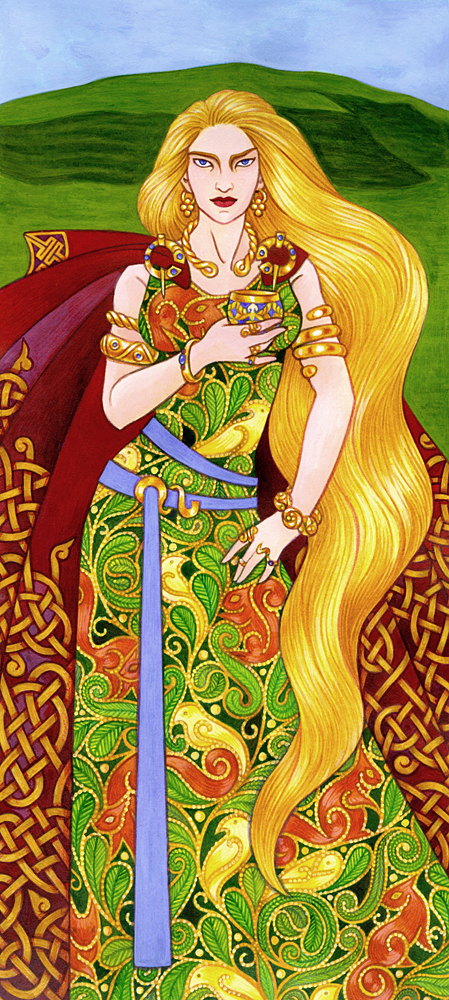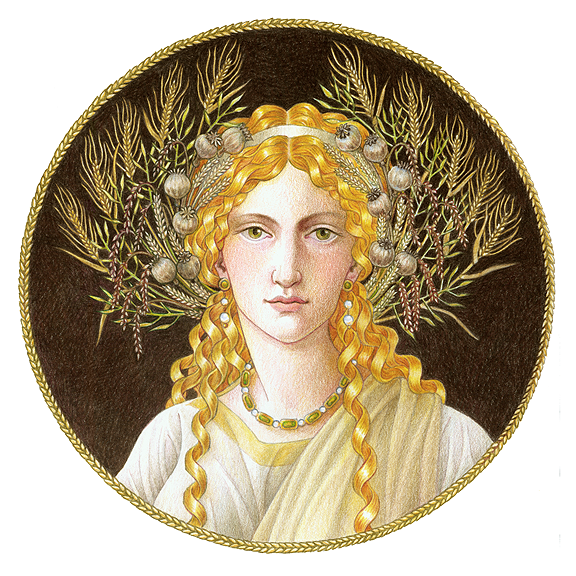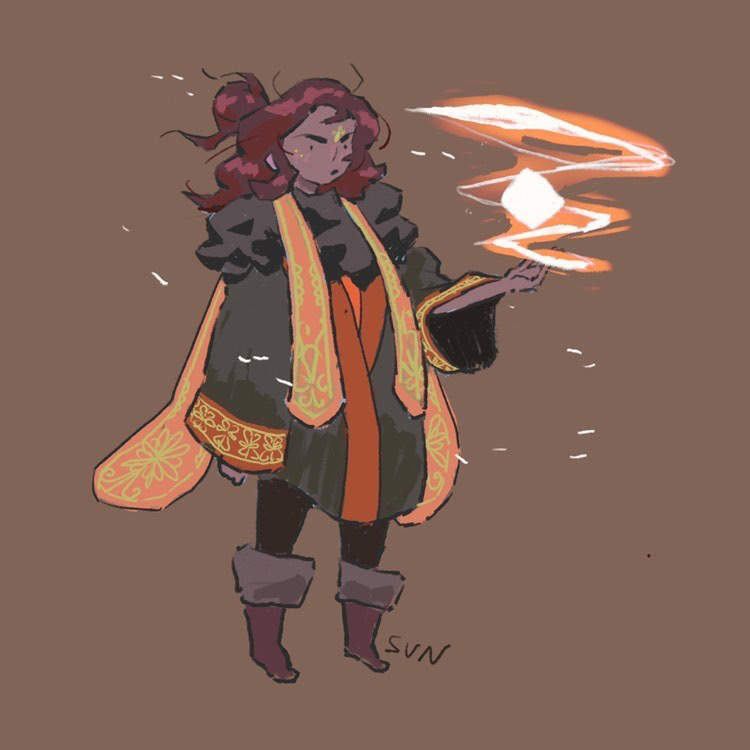Then shall the good stand in immortal bloom,
In the fair gardens of that second birth;
And each bright blossom mingle its perfume
With that of flowers, which never bloomed on earth.
In the east She is Mokosh, and the west Donisa. Though to all of us Lady Galana is the Mother.
We are taught of the birth of the Elder Gods, one born of Chaos another of Magus and Galana was born of the Mortal Realm. While Courga and Fourga established themselves in the New Great Dance, Galana faced the toughest challenge trying to find Her place in the Realm that was Throff's wintery domain. Forced to be imprisoned in the Corryvreckan, Galana could not break free without the warmth of Courga's Summer across the Star Bridge for Her Spring life to move towards. If we end in our faith of our shared Mother, who knows if we would ever escape the constant Winter.— 'Lady Galana; Mother of All Humanity'
Epithets
The Spring Queen
Clerical Domains
Portfolio
Attribute
Life, Unity
Agriculture, Community, Family, Fertility, Harvest, Hearth, Marriage, Maternity
Green or Flowered Scythe & Sable or Knot
Lady Galana the Spring Queen is the official Elder God interpretation in the faith of the Holy See. As such, She is depicted as a defender of life, virtue and light, and is an opposing light against the Great Hag Throff's darkness. Prayers and sermons often depict the two deities playing an intricate game for eons, with Lady Galana defending the nature of the Mortal Realm against Throff's death, corruption and darkness. Lady Galana is praised to be the bastion of peace, light and good.
The Spring Queen represents the more civilised aspects of Lady Galana. The sense of community is vital to the faithful of the Spring Queen, stating that She values the stability and measured approach of civilisation to conquer the wilds and make use of it to prosper. This has come into blows with many cults who venerate Varantar, as they promote a border between civilisation and wilderness that must be upheld. In any case however, Lady Galana is praised as loving and protective. She is often prayed to for mercy, and to keep loved ones safe. Most houses in the Holy See Territories will have a depiction of Galana carved into their doorways to ensure this safety is brought into their homes.
The Giver of Fruits
Clerical Domains
Portfolio
Attribute
Light, Nature, Blood
Balance of Life & Death, Beauty, Fertility, Harvest, Nature, Rebirth
Scythe with a Blood or Wine Drop
Galana the Giver of Fruits is the modern iteration of the pre-Holy See worship of Galana, sometimes called Mokosh, Donisa or any other multitude of regional names that have survived outside the Holy See Territories. The Giver of Fruits is the representation of the more natural aspects of Galana, though not as elemental as the third of Her epithets.
In the past, as well as continued by some Minotaur tribes, the Giver of Fruits was worshipped through blood rituals. The remnant of the blood sacrifice tradition is the belief that Galana is the patron of the easing of suffering, which is still portrayed in Her balance of nature and assistance of pregnant women. Followers of the Giver of Fruits believe Galana is the soother of the tormented, providing succour in times of distress. Prisoners, the sick, the poor, and the destitute all seek Her favour, as do the priesthood who wish to ease the world’s suffering.
Creator of the Elements
Clerical Domains
Portfolio
Attribute
Nature
Nature, Spring
Nothing (nature itself)
The Creator of the Elements is the least venerated of all epithets of Galana, mostly among Elemental Cults and Warlockian Temples that hug in their highest numbers the coasts of the Silverlight Sea. The Creator of the Elements is viewed as the Queen of the four Prime Elementia, ruling over all of Elementia Realm. The Creator of the Elements is the representation of pure elemental nature being harnessed and controlled. She governs only nature, with no temples dedicated to this Galana existing; instead Elementia Temples will contain a centrepiece statue of Galana.
As the embodiment of Spring, where elements are reborn each year, Galana is seen as the natural enemy of Throff due to Throff's control over both the Winter elements and over storms through Her Storm Hags who Galana finds are uncontrollable and cannot rule over. This has led to Tonitrus becoming an important figure in the Elementia Cults, as the Prime Elementia of Storms. Some cults have gone so far as to depict Galana's lover as being Tonitrus instead of Courga, though such adulterous imageries have been outlawed in the Holy See Territories where Elemental Cults are leniently permitted.
Worship in the Holy See
As one of the three Elder Gods to which all deities are born from, Galana is a major god of the Holy See's pantheon with an Archbishop on the Pontifex Maximus' Inner Council representing Galana on the Mortal Realm. The current Archbishop of Galana is Doryanna Quistley of Arkleton.
The Priesthood of Galana in the Holy See - referred to as
Acolytes - dress themselves in
vestments of Her holy colour,
green, which increase in floral and natural decorations to match their depiction of the Spring Queen as they rise in the
priesthood ranks. Acolytes often also dye their hair or wear wigs to match Galana's blonde.
Acolytes and Clerics who reside in Temples of Plenty resemble more gardeners than priests, acting as advisors and healers: predicting the optimal times for planting and harvest; using little-known medicinal plants to cure illness; overseeing festivals of the harvest. Many Acolytes are shepherds and farmers in their own right, unafraid of an honest day’s work planting crops or tending to livestock.
Temples
Temples of the Holy See, known as Galaneions, are also referred to as Temples of Plenty like those dedicated to the Giver of Fruits. These Temples of Plenty are open-aired courtyard-styled buildings, that often double as gardens, greenhouses and nature preserves. Temples of Plenty are usually found in remote farming and fishing towns rather than larger cities, though a statue-shrine called a Galaneion will be present in a city outside orphanages.
These blessed gardens often contain rare plants and animals with healing and other magical properties, which coincide with the holy tome of '
Bounty of the Springmother' to which every Galaneion - including minor statue-shrines with only one Priest - holds a communal copy of. Richer Temples of Plenty will also feature a bust of the philosopher poet
Basho, for his dedication to the faith and writings that are now considered holy texts in the Holy See.
All Temples of Plenty double as places where women of all races in the Holy See Territories prefer to give birth, commoners and nobles alike. This is due to the fact every Priestess of Galana is also a trained midwife, as holy places of the goddess are believed to be blessed to stay away the Curse of Galana. This Curse refers to the origin myth of Humanity, where it is largely believed Galana suffered from a miscarriage and the blood from this fell to the Mortal Realm, mixing with the clay off the coast of the Copper Sea.
Festivals
The festivals of Galana revolve around the harvest year, with two major holy days occurring every year. Acolytes of Galana and Nature Clerics devoted to Galana oversee these harvest festivals in the Holy See Territories, travelling through the farmlands to assist where they can.
Imbolg is the mid-point between the Winter and Spring Equinoxes, the beginning of Galana's rule over the Mortal Realm and start of the second month.
In the weeks following Imbolg, the Acolytes and Clerics travel the farmlands, blessing the seeds, then the newly planted crops, and helping the farmers in tilling the fields and sowing seeds etc. In late Autumn, during the festival of
Harvest Close at the end of the harvest season. Temples of Plenty hold community feasts and potlucks, bringing farm folk together to celebrate another successful harvest.
Factions of Worship Within the Holy See
There are three major sects which differ slightly from the normal tenets of the Holy See's worship of Galana, but are leniently accepted without claims of heresy under Canon Law by the Heldenic Inquisition. The Reapers of the Curse predate the Holy See, and are a warrior-temple who follow in the footsteps of Scythe-Saint Bride. Bride was a mythical warrior of the Invasion of Mortis Realm, who bore witness to Lady Galana Herself at the banks of the Lake Heron and granted the warrior-nun Her own scythe artefact and holy rejuvination after she suffered a miscarriage before descending into Mortis. The Reapers are all those who have suffered from the Curse of Galana, and train as expertise light shock units wielding war-scythes.
The majority of Clerics of Galana which are trained under the Holy See are integrated into a major Clerical Order known as the Queen's Servants who follow the clerical Scythe-Saint Vesta. The Queen's Servants are the enforcers of Galana's gift to mortality where pure nature meets civilised society. Many Servants come from communities that have a healthy respect for the importance of society and culture. The Servants' abilities revolve less around protecting and channelling nature, and more about bending nature to serve their own will. Where Druids protect untamed wilderness, these Nature Clerics protect farms, gardens, and other places where man and nature must coexist.
Not all Acolytes of Galana in the Holy See assist with rural agriculture, and those who follow Scythe-Saint Nympha practice their faith within urban communities. This minority sect, known as the Sisterhood of the Knot, run the Temples of Plenty in towns and cities in order to service the population centres of women who may not be able to move out to the rural countryside when they are heavily pregnant. These Temples of Plenty will double as orphanages, teaching and nurturing children who have no parents in order to be able to survive in the future. Often, these orphans will themselves become Acolytes of Galana and join the Sisterhood. For commoners in the Holy See Territories, these are often the temples where marriages are held if the culture permits such holy ceremonies.









The Epithets section makes my classics brain happy :D Loved the article! Very interesting, and you've gone into lots of detail about different ways that Galana is worshipped.
I only have a really basic understanding of epithets but since first exploring Assassin's Creed: Odyssey I have been enthralled by the idea and how much sense it makes. Almost makes me wish Elder Scrolls had a similar system etc. Though I am very glad a classics grad enjoyed! :D